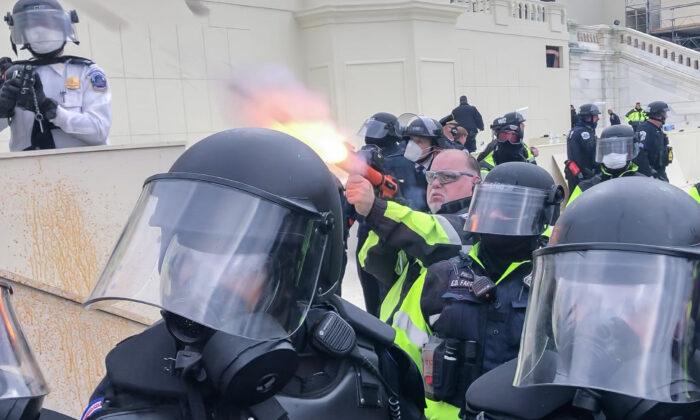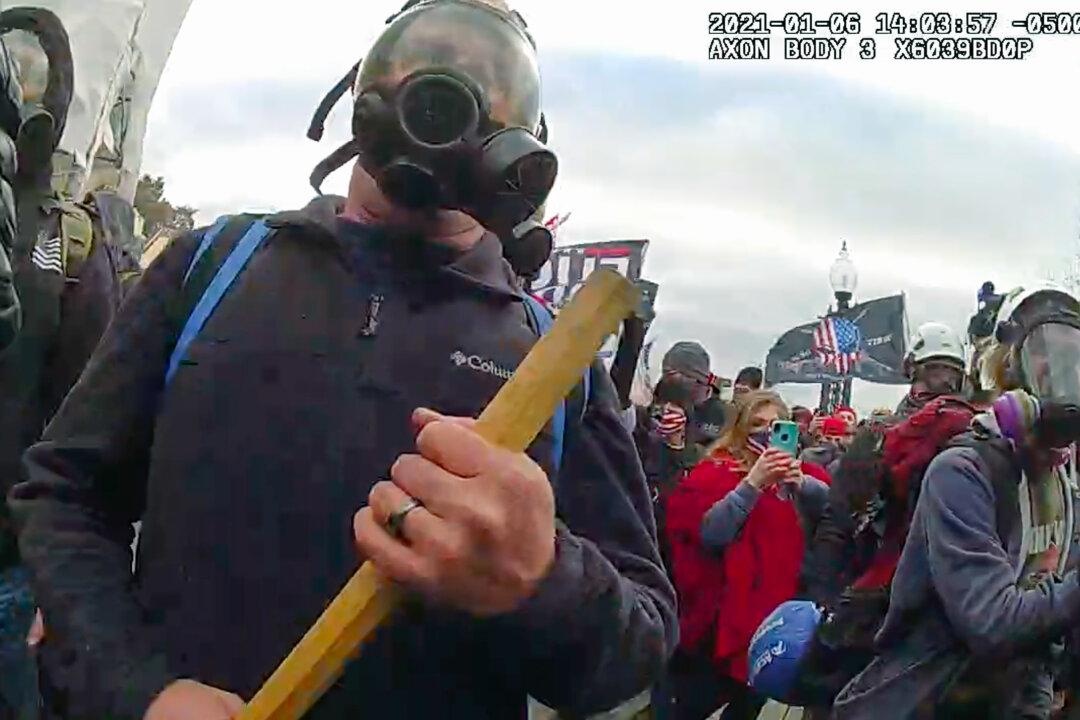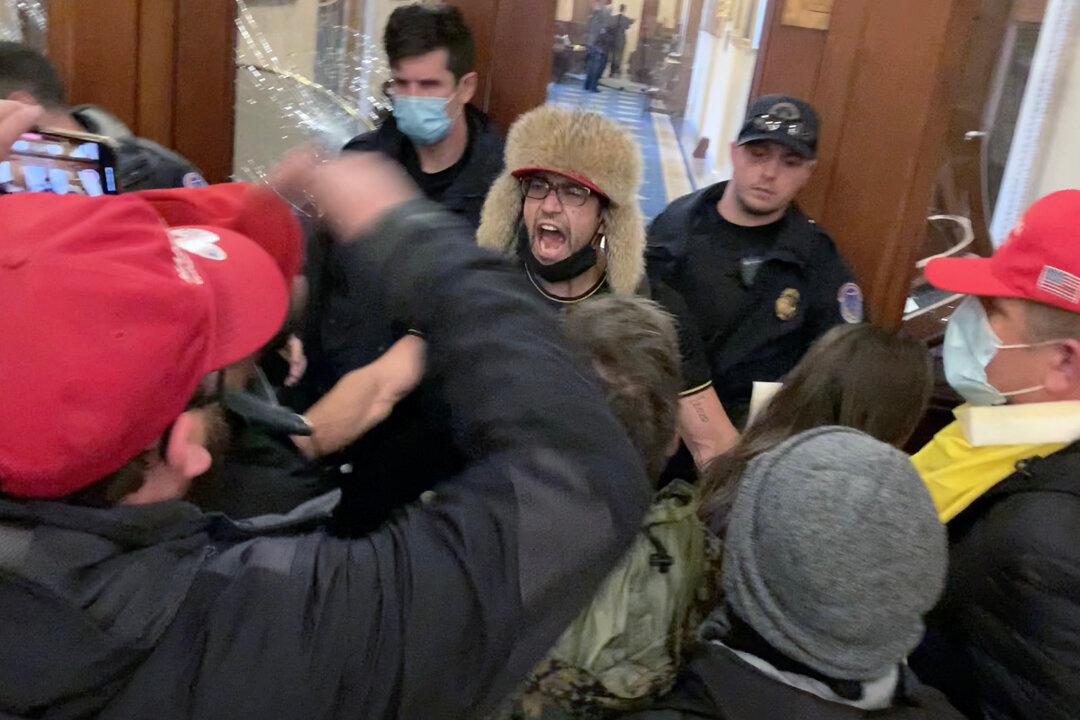Mark Griffin never saw it coming.
He stood at the police line on the west side of the U.S. Capitol on Jan. 6, 2021, engaged in friendly conversation with officers about why he had come to Washington.
Without warning, police picked up the metal bicycle racks that served as barricades and rushed forward into the crowd. Griffin was sprayed in the face with pepper gel.
Hell was breaking loose.
BOOM. THUD.
Griffin found himself on the ground, dazed and confused. He had a vague sensation that his left leg was injured just above the knee.
All around him, blinding flashes were punctuated by a whump and crack that knocked people off their feet.
The day was peaceful no more.
“I went down, and some people helped me up,” Griffin told The Epoch Times. “I had no idea how bad I got hurt.”

As he struggled to his feet, Griffin leaned on the cane he brought for protection from attacks he feared would come from Antifa. It would be his only means out of a quickly deteriorating melee between police and protesters.
Griffin didn’t realize at the time that his left femur was split in two lengthwise. The massive trauma came from a 38mm to 40mm shell, almost certainly fired from a munition launcher behind the police line.
His leg quickly swelled, creating a natural pressure splint that allowed him to limp from the scene on a broken leg toward the bus he rode from Pennsylvania.
The first serious police injury occurred about 40 minutes earlier, when a Capitol Police officer was knocked off her feet and struck her head on a concrete step. Griffin was among the first casualties among protesters on a day when four Trump supporters died and scores of police and protesters were injured.
Terror in Their Eyes
Griffin’s mind reeled as he struggled to get away from the Capitol. What just happened? He had been part of a peaceful assembly that in a heartbeat turned into a war.
“It came from my left someplace,” Griffin said from his home in Canadensis, Pennsylvania, about 70 miles northwest of New York City. “I can’t figure it out. It had to be one of those cops right in front of me, because from the left up in the parapet, you just didn’t have a clean shot at my left knee.
“From up there, you’d have to shoot over the heads of those cops, and you'd be hitting them.”
It’s unclear if Griffin was shot accidentally or deliberately. Numerous police officers working near the barricades on that end of the grounds were armed with orange munition launchers. While several officers repeatedly fired grenades, beanbags, and explosive shells into the air, video footage shows at least one officer standing at the bicycle racks aimed the launcher directly at protesters standing just feet away.
Griffin had strolled up to the police line about a half-hour earlier, along with hundreds of other protesters who walked to the Capitol after President Donald Trump’s speech at the Ellipse.
He said there were no indicators of trouble as he approached the Capitol’s west side via the Peace Monument. No signs. No verbal warnings.
Griffin said he never heard the droning of the still-unidentified “scaffold commander”—who barked instructions over a bullhorn that included, “Move forward, patriots!”—from high above the gathering masses.

“There was no indication that you weren’t supposed to go into that area,” said Griffin, a self-employed dump truck driver. “So there was nothing really to stop me. I had no idea that the line that I was headed to at the bottom of the steps there was actually the [police] fall-back line.”
The first thing that Griffin noticed when he stopped at the barricades was the fear in the eyes of some of the Metropolitan Police Department officers. He wondered just what police were expecting from the crowd. If it was violence, he was determined to have no part in it.
“I spotted this one young cop, and in his face was just, I mean, he was terrified,” he said. “I never saw anybody terrified like that before in my life. His head was jerking around, and he was like, his face was twitching.
“I said, ‘Man, this guy’s going to panic and shoot somebody or something,’” Griffin said. “I realized that was going to be me. I’m not sure he was the guy that shot me. But anyhow, I just felt I had to connect with that guy.”
Griffin urged the young officer to be calm, assuring him he had nothing to fear from the crowd. Griffin looked around and saw no one in the vicinity causing trouble.
“He couldn’t have been more than 22 or 23, a baby,” the 64-year-old Griffin said. “I pulled my wallet out and I showed him my ID and everything because I didn’t want him to think that I was going to do anything to him.”

Griffin isn’t a threatening presence. His calm and steady voice bears a remarkable resemblance in timbre and characterization to the late comedian Jackie Vernon, known by millions as the voice of Frosty the Snowman in the animated 1969 film of the same name.
Griffin took off his camo-color cap and showed another officer an image of the Constitution printed on the back.
“Here is my bill of sale to this country; you know, my birth certificate,” he told the officer. “I said, ‘It’s your bill of sale, too. It’s our country. It’s not their country. And what they’re trying to do inside that building in there is just not right. And everybody knows it’s not right.”
“And he just said to me, ‘Well, you voted. Go home.’ And I told him, ‘You know I’m from Pennsylvania. I can’t go home, because we have all kinds of questions about the election. Our legislature sent the House of Representatives a letter asking that they not recognize the electors that were sent. That’s why I’m here.’
A Breakdown of Order
Griffin began to see signs of trouble brewing. A few loudmouths began to insult police and grab at the bike racks. Griffin yelled at them to knock it off and get back. That worked—for a while.Off to his left, a police supervisor unleashed a torrent of pepper spray from a tank that was the size of a fire extinguisher.
“I see people, on our side of the fence, spraying pepper spray back at him with the same kind of canister,” Griffin said. “‘Wow,’ I thought, ‘Isn’t that a coincidence? How did they wind up with the same canister of pepper spray on both sides?’ That stuck out in my head.”
Griffin said he helped reconnect sections of the barricade when a provocateur pulled them apart.
“I helped him reconnect the railing. So, I was helping him,” Griffin said. “People were starting to push the railing. I was yelling at them, ‘Stop doing that! Don’t do that!’”

A short time later, he noticed explosions. Video shows police throwing dispersion grenades into the crowd and firing rubber bullets from the terrace above. Riot police emerged from beneath the scaffolding to Griffin’s left and began battling with protesters. Furious fighting ensued.
Anger swept through the tightly packed crowd when protesters realized they were under attack.
At 1:50 p.m., a Metropolitan Police officer fired a shell over Griffin’s head into the crowd, where it exploded. Pieces of the wadding floated down onto bystanders.
“Hey, you missed!” a man mocked. “We’re not the enemy!” a woman added.
The trek back to the bus was perilous. Griffin decided against taking the multiple sets of stairs he had traversed on his way in. The shortcut required him to scale and slide over a 4-foot wall, which he did with the help of strangers.
At the corner of First Street and Constitution Avenue, Griffin noticed a man 0utfitted in a battle-dress uniform, talking on a radio or satellite phone.
‘I Didn’t Realize My Leg Was Broken’
“So, I said to him, ‘Hey, mister, take a look at this what happened to me.’ I put my pant leg up and I showed him. He didn’t say anything. I’m on my way and I’m having more trouble walking because the swelling is going down. I didn’t realize my leg was broken.”As he continued hobbling down Constitution Avenue, he lost his balance and fell.

“I got a couple of blocks and I actually fell down in the road,” Griffin said. “I couldn’t get up and a guy came over.
“He said, ‘Do you want me to call an ambulance?’ I said, ‘Nah, if you could just help me up, I can make it. I got the cane here.’”
When he finally reached the bus at Constitution and Sixth Street, he took the weight off the broken leg, which was now causing terrible pain as the swelling subsided.
A police officer came on the bus and said everyone had to evacuate due to a possible car bomb. Griffin said he limped past a vehicle with what appeared to be jumper cables coming out from under the hood. He found it odd, but a car bomb?
“I’m thinking in my head, ‘That’s the phoniest looking bomb threat I ever saw,’” Griffin said. “So I just told the bus driver, ‘Look, I’m not getting off the bus. I’m hurt, I’m in the seat now, I’m not moving.”
After the bus ride back to Pennsylvania the night of Jan. 6, 2021, Griffin somehow managed to get into his vehicle at the park-and-ride lot and drive to the hospital. After X-rays and some other tests, they sent him home.
“They just told me, ‘Well, we’re going to send you home with crutches. It looks like it’s just like a localized trauma. You should be fine.’
“So I get home the evening of January 6 and I get a phone call,” Griffin said. “'You have to come back to the hospital because your leg’s broken.”
Surgeons took a couple of days to come up with the best strategy to knit the femur back into one piece, he said. An incision was made along the side of his leg.
“My whole leg was black and blue from the toes all the way up to my hips,” he said.
A titanium plate became the internal splint, secured by more than a dozen screws. It took six months before Griffin could put full weight on the leg, and another seven months before the titanium was removed.
A few days after Griffin returned home to convalesce, a detective from the Monroe County Sheriff’s Office paid him a visit. He asked if Griffin owned a camouflage jacket. Then, he inquired if he had a set of aluminum medical crutches.
He answered “yes” and “no.”
Heavy Weapons Aimed at the Crowd
The heavy use of kinetic impact weapons on the crowds on Jan. 6, 2021, was unprecedented at a Capitol protest. The practice was called out as reckless by one police expert in The Epoch Times’ recently released documentary, “The Real Story of Jan. 6.”Consultant Stanley Kephart said police used incendiary devices, tear gas, and projectiles to punish the crowds without attempting to accomplish a strategic objective such as dispersing people away from the building. Use of such weapons—especially in close quarters—carries risks such as serious injury or even death.
Brianna Burch, public affairs specialist for the Metropolitan Police Department, said “all use of force actions are investigated per department policy, including any use of munitions on Jan. 6, 2021.” She referred The Epoch Times to the department’s freedom of information liaison for the actual reports.

Police munitions can have a variety of payloads, including plastic or rubber pellets, chemical irritants such as oleoresin capsicum or CS gas, colored smoke, sponge-tip projectiles, or small sections of wood batons. The “less lethal” weapons exit the barrel of the launcher at speeds that can exceed 240 feet per second.
Most rounds aren’t intended to be aimed directly at individuals.
“The findings of a systematic review of global medical literature carried out by Physicians for Human Rights (PHR) indicate that KIPs (kinetic impact projectiles) cause serious injury, disability, and death,” according to a bulletin from the International Network of Civil Liberties Organizations. At close range, the report said, “they are likely to be lethal.”
Such projectiles can strike the eyes, causing blindness, or even penetrate the eye socket into the brain, a PHR report said. Projectiles can cause bruising of the lungs or heart, internal bleeding, and even heart attacks.
Two men—Kevin Greeson and Benjamin Phillips—died on Jan. 6, 2021, from cardiac events. While both men were in close proximity to explosions from police munitions, the medical examiner ruled they died of natural causes from heart disease.
Griffin said his Jan. 6, 2021, ordeal led to deep divisions in his family. Two sisters refuse to speak with him anymore, and a beloved uncle blamed him for the leg injury.
“He said, ‘Don’t call me again,’ and he hung up the phone on me,” Griffin said. A letter he wrote to his sisters explaining his presence in Washington on Jan. 6, 2021, went unanswered, he said.
“My mom—who’s 95—she still believes in me,” he said.
Griffin said he will decide about a civil suit against police if control of Congress shifts to the GOP from Democrats. Until then, he says he'll continue to tell his story.
“Other people should know about it, because this can happen to them, too,” he said. “It’s not right. This isn’t what your government is supposed to be doing. Your government is supposed to be protecting you.”





